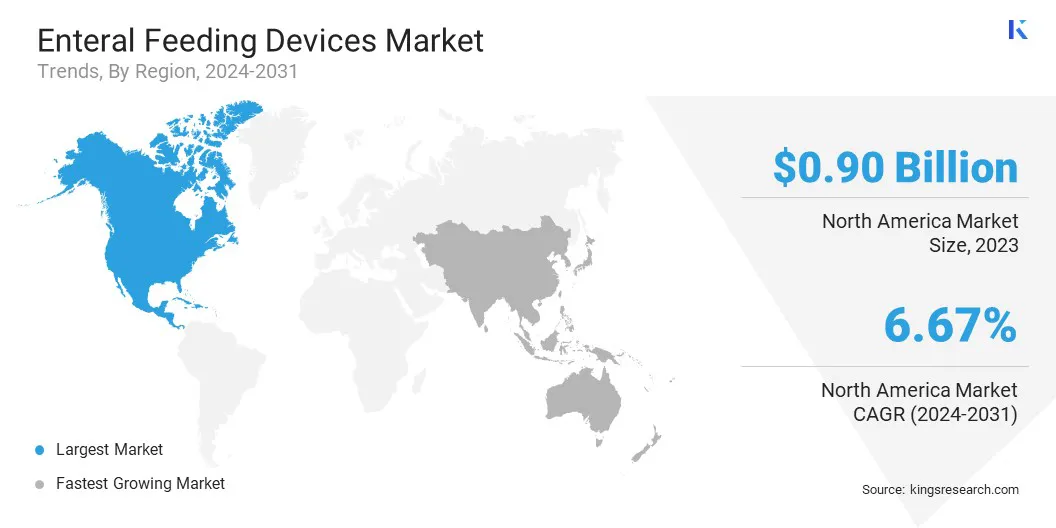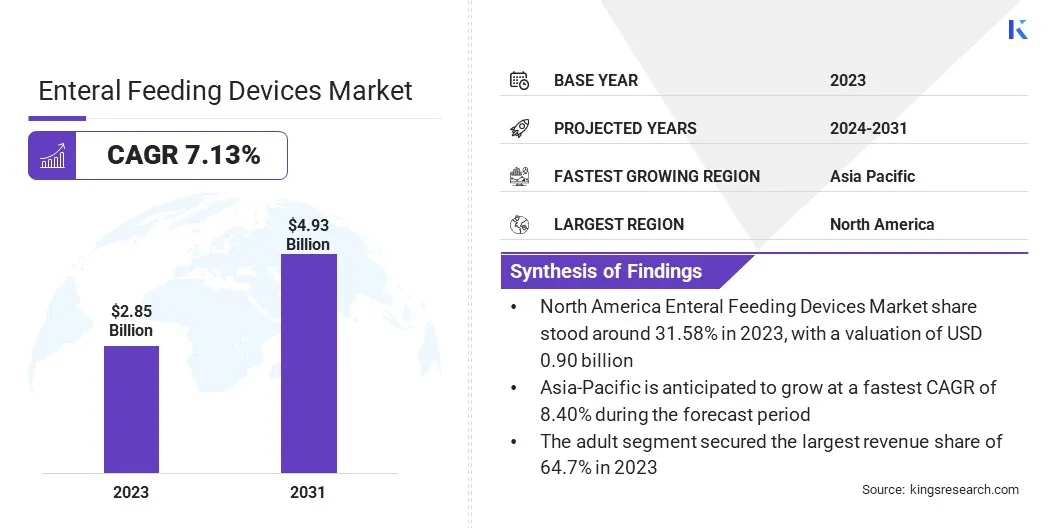Enteral Feeding Devices Market Size
The global Enteral Feeding Devices Market size was valued at USD 2.85 billion in 2023 and is projected to reach USD 4.93 billion by 2031, growing at a CAGR of 7.13% from 2024 to 2031. In the scope of work, the report includes products offered by companies such as Braun SE, Abbott, Boston Scientific Corporation, Conmed Corporation, Becton, Dickinson and Company (BD), Cardinal Health Inc., Avanos Medical, Inc., Neomed, Cook Medical, Baxter and others.
The enteral feeding devices industry is poised to witness stable growth over the forecast period, driven by the consequences of the COVID-19 pandemic, demographic changes such as growing geriatric populations, increased rate of premature births, and the expanding utilization of home-based healthcare services.
The development of the market is likely to be driven by factors such as the prevalence of chronic diseases, including cancer, diabetes, and neurological disorders. With a growing geriatric population worldwide, the need for efficient and reliable means of nutritional support is increasing. Enteral feeding devices offer a key solution, ensuring patients receive essential nutrients directly into the gut when oral intake is inadequate or undesirable. As healthcare providers prioritize patient nutrition and well-being, the demand for enteral feeding devices is expected to surge and aiding overall enteral feeding devices market growth.
Enteral feeding devices encompass a range of medical devices and equipment designed to deliver nutrients directly into the gastrointestinal tract for patients who are unable to consume food orally. These devices play a critical role in providing essential nutrition and hydration to individuals with conditions such as dysphagia, neurological disorders, gastrointestinal diseases, critical illness, and those undergoing medical treatments that impair their ability to eat or drink normally.
Key components of the enteral feeding devices include feeding tubes, pumps, syringes, and other, accessories necessary for enteral nutrition delivery. These devices are utilized across various healthcare settings, including hospitals, home care settings, ambulatory care centers, and others.
Analyst’s Review
The development of the market is likely to be driven by factors such as the growing incidence of chronic illness, technological advancement, preterm birth, and the aging population. Additionally, market players are implementing expansion strategies such as product launches and partnerships to capitalize on emerging opportunities in the market.
With healthcare systems increasingly prioritizing patient nutrition and well-being, the enteral feeding devices market is slated to observe strong growth in the coming years.
Enteral Feeding Devices Market Growth Factors
The growth of the enteral feeding devices market is mainly driven by the onset of the COVID-19 pandemic and the subsequent increase in the global healthcare burden. The impact of the virus, particularly on the gastrointestinal tract of severely ill patients, has accentuated the need for enteral nutrition support.
Research indicates that COVID-19 patients, especially those in intensive care units (ICUs), experience compromised intestinal mucosa, inflammation, stress, and increased catabolism, necessitating immediate and adequate nutrient intake to prevent malnutrition.
- For instance, guidelines issued by medical bodies such as the European Society for Clinical Nutrition and Metabolism (ESPEN) recommend gastric enteral nutrition through devices equipped with flow regulators for severe COVID-19 cases. This has strengthened the demand for enteral feeding devices, which is expected to boost product demand over the forecast period.
Moreover, the rising incidence of premature births, as emphasized by the World Health Organization (WHO), is further amplifying the demand for enteral feeding devices. The increase in premature births, coupled with the understanding that preterm infants are more prone to malnutrition and associated complications, underscores the importance of enteral nutrition in neonatal care. These infants, born before 37 weeks of gestation, face significant challenges due to their underdeveloped organ systems and physiological immaturity.
By providing precise control over nutrient intake, promoting gastrointestinal maturation, supporting immune function, and fostering optimal growth and development, enteral feeding plays a crucial role in improving outcomes for preterm infants. As the demand for enteral feeding devices tailored to the needs of preterm infants continues to grow alongside the rising incidence of premature births, ongoing research and innovation in neonatal nutrition are essential to optimize care practices and enhance long-term outcomes for the expanding population.
Enteral Feeding Devices Market Trends
The trend toward providing healthcare services in home care settings is growing rapidly, fueled by patient preferences for convenience and independence. This shift has led to increased demand for enteral feeding devices suitable for home use. Manufacturers are enhancing product offerings by innovating device designs to make them more user-friendly and accessible outside clinical settings.
Key considerations include intuitive operation, portability, and stringent safety standards. The growing usage of these devices in home care settings is helping improve users' lifestyles and enabling key players to solidify their position in the enteral feeding devices market.
One of the most notable trends in enteral nutrition is the widespread adoption of closed systems. These innovative systems have revolutionized enteral nutrition administration by providing a closed pathway for nutrient delivery, minimizing the risk of contamination and infection. By shielding the feeding tube and the patient from external contaminants, closed systems offer enhanced safety and reduce the risk of complications associated with traditional open systems.
A key advantage of closed systems is their versatility in facilitating the administration of nutrition, medications, and other treatments through the feeding tube. With the scalability and flexibility of feeding tubes, businesses strive to adapt to changing market trends and consumer preferences more effectively, optimizing their advertising strategies for better performance and ROI.
Segmentation Analysis
The global market is segmented based on product type, application, age group, end-user, and region.
By Product Type
Based on product type, the market is segmented into enteral feeding tubes, enteral feeding pumps, administration sets, enteral syringe, and others. The enteral feeding tubes segment led the enteral feeding devices market in 2023, reaching a valuation of USD 1.04 billion. Enteral feeding tubes, ranging from nasogastric to specialized configurations, are important for delivering nutrients directly into the gastrointestinal tract for patients unable to consume food orally.
Compatibility with closed systems and modern device connectors further boosts their utility and safety. With increasing demand for enteral nutrition and home-based care, enteral feeding tubes play a pivotal role in ensuring optimal nutrition support for patients and driving market growth.
By Age Group
Based on age group, the enteral feeding devices market is bifurcated into adult and pediatric. The adult segment secured the largest revenue share of 64.7% in 2023. Enteral feeding devices play a vital role in supporting the nutritional needs of adults facing various medical challenges. For individuals afflicted by neurological disorders like stroke, Parkinson's disease, or traumatic brain injury, difficulties with swallowing or impaired gag reflexes can impact their livelihood.
Similarly, cancer patients undergoing treatment often encounter side effects such as nausea, mucositis, or gastrointestinal obstructions, necessitating alternative means of nutrition delivery.
Additionally, adults with gastrointestinal disorders such as Crohn's disease or severe malabsorption syndromes may struggle to absorb nutrients from food, leading to malnutrition or weight loss. Enteral feeding devices are indispensable in providing essential nutrition and support for adults facing diverse medical conditions, ensuring they receive the sustenance necessary for recovery and well-being, which is a key factor driving segment growth
By End Use
Based on end use, the market is classified into hospitals, home care settings, and ambulatory care settings. The hospitals segment is estimated to expand substantially at a CAGR of 45.6% through the forecast period. This growth is fueled by growing awareness among healthcare professionals regarding hospital-associated malnutrition, which is leading to an upsurge in the use and demand for enteral feeding devices within hospital settings.
Additionally, factors such as the rising number of ICU admissions and re-admissions, coupled with the increasing demand for enteral foods and formulations among critically or severely ill patients, are contributing to segment growth
Enteral Feeding Devices Market Regional Analysis
Based on region, the global market is classified into North America, Europe, Asia-Pacific, MEA, and Latin America.

The North America Enteral Feeding Devices Market share stood around 31.58% in 2023 in the global market, with a valuation of USD 0.90 billion. The region is poised to hold a substantial share of the global industry in the forecast period, driven by the rising burdens of chronic diseases and surgical interventions. Additionally, data from the Canadian Cancer Society highlights that the incidence of conditions such as stomach cancer, is further contributing to the demand for enteral feeding devices for nutrition management.
Market growth is further fueled by strategic initiatives by key players, such as the introduction of Nasogastric Tubes by QMD and the clearance of Vonco Products' EnteraLoc Flow system by the USFDA. These developments underscore the market's trajectory toward significant expansion, driven by mounting disease burden and product innovation.
The Asia-Pacific enteral feeding devices market is expected to experience significant growth at a CAGR of 8.40% over the forecast period. Factors such as the increasing prevalence of chronic diseases, rapid urbanization, and aging populations contribute to the growing demand for enteral feeding devices across the region.
For instance, surging occurrences of conditions like diabetes, cancer, and gastrointestinal disorders are impelling the need for enteral nutrition support. Moreover, as healthcare infrastructure continues to improve and access to medical care expands in countries across the Asia Pacific, there is a greater emphasis on providing comprehensive nutritional support, including enteral feeding, to patients in both clinical and home care settings.
Competitive Landscape
The enteral feeding devices market report will provide valuable insight with an emphasis on the fragmented nature of the industry. Prominent players are focusing on several key business strategies such as partnerships, mergers and acquisitions, product innovations, and joint ventures to expand their product portfolio and increase their market shares across different regions.
Strategic initiatives, including investments in R&D activities, the establishment of new manufacturing facilities, and supply chain optimization, could create new opportunities for market growth.
List of Key Companies in Enteral Feeding Devices Market
- Braun SE
- Abbott
- Boston Scientific Corporation
- Conmed Corporation
- Becton, Dickinson and Company (BD)
- Cardinal Health Inc.
- Avanos Medical, Inc.
- Neomed
- Cook Medical
- Baxter
Key Industry Developments
- March 2022 (Partnership): Vygon made a notable acquisition by acquiring Macatt Medica. This strategic collaboration was aimed to enhance Vygon's presence in South America, specifically in the field of enteral feeding products.
- November 2022: Amsino Medical Group Company obtained clearance from the U.S. Food and Drug Administration for its AMSafe NeuFlo™ Needleless Connector. This connector is designed to work as a single use, non-pyrogenic and sterile device. It provides needleless access to intravascular administration sets, facilitating the administration of fluids to patients through a cannula positioned in either a vein or artery. Notably, this device safeguards patients against potential infections, as it is intended for single -use and is not meant to be reused.
The Global Enteral Feeding Devices Market is Segmented as:
By Product Type
- Enteral Feeding Tubes
- Enteral Feeding Pumps
- Administration Sets
- Enteral Syringe
- Others
By Age Group
By Application
- Oncology
- Gastroenterology
- Neurological Disorders
- Diabetes
- Other Applications
By End Use
- Hospitals
- Home Care Settings
- Ambulatory Care Settings
By Region
- North America
- Europe
- France
- U.K.
- Spain
- Germany
- Italy
- Russia
- Rest of Europe
- Asia-Pacific
- China
- Japan
- India
- South Korea
- Rest of Asia-Pacific
- Middle East & Africa
- GCC
- North Africa
- South Africa
- Rest of Middle East & Africa
- Latin America
- Brazil
- Argentina
- Rest of Latin America


